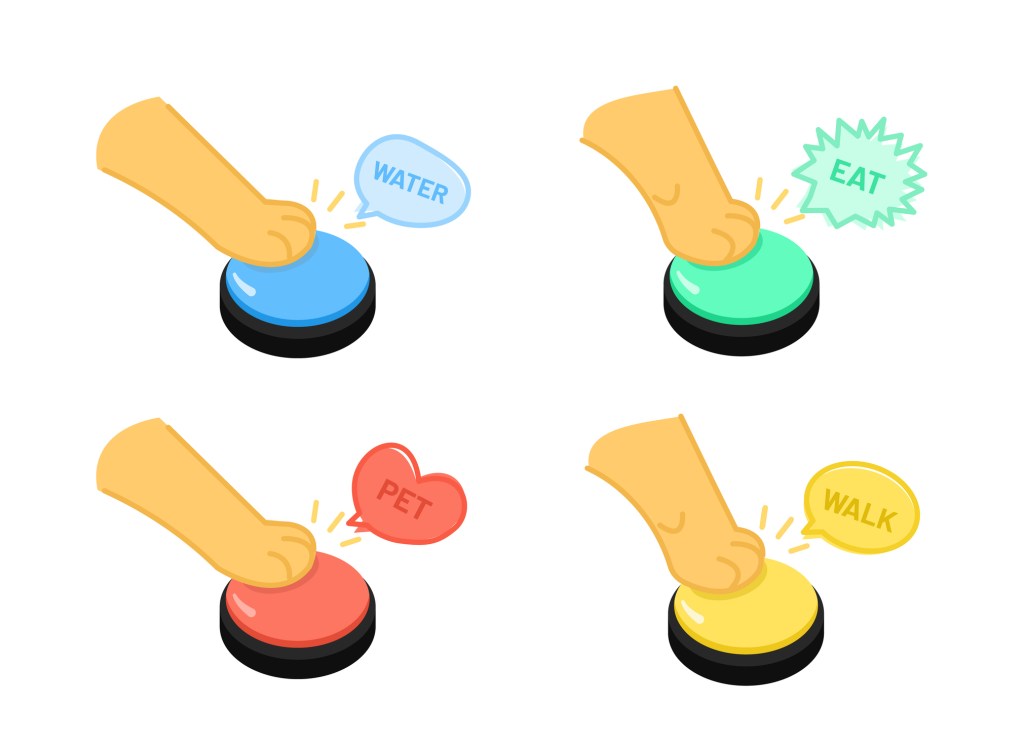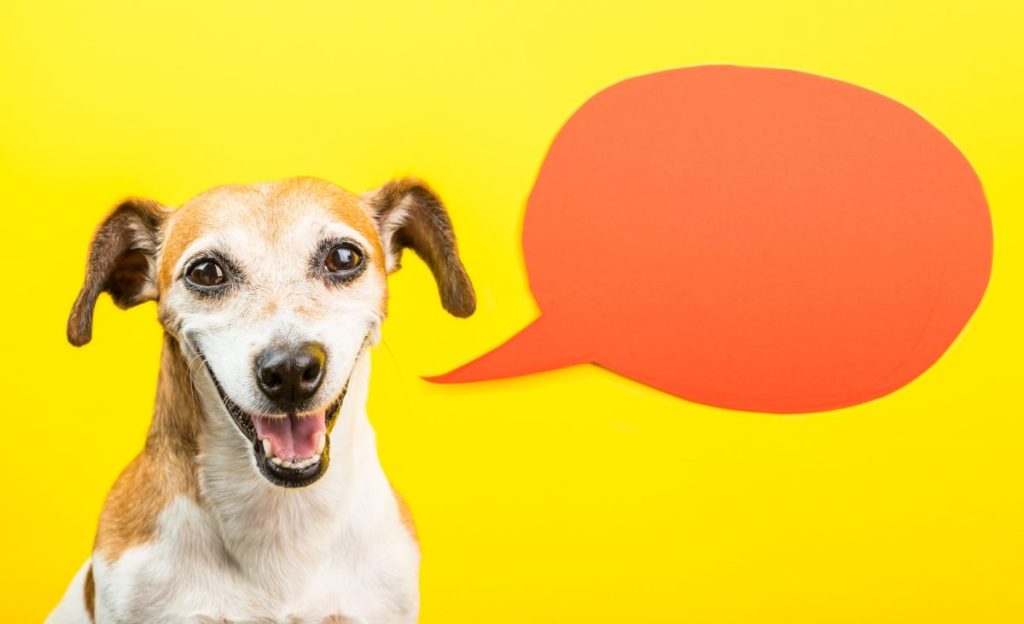Maybe you’ve spent some time researching dog buttons and are eager to learn more. Or perhaps you’ve already ordered the best-reviewed dog buttons, and you’re sitting at home with a half-dozen, unsure of what to do next. Either way, you’ve landed on this page, and we’re happy to help! Let’s start with the basic button training tips and get you started teaching your pup to “speak” using dog talking buttons.
What are dog talking buttons?
We’re going to take a guess and assume you’re somewhat familiar with this concept and already know all about the benefits of dog buttons. However, just in case you’re new to these devices, dog buttons have taken the pet parent world by storm in recent years. Videos on social media have surfaced showing pet parents communicating with their dogs, and even other pets. One viral TikTok video shows an adorable pig named Merlin using dog buttons to ask for his favorite treat.
These useful tools are helpful for various reasons, but the general idea is that they can help your dog communicate their needs to you. We all know we’ve spent a good amount of time teaching our dogs the fundamentals of training and basic commands when we want them to sit, stay, or come. It’s only fair our pets should also be able to communicate their wants, like food, outdoor time, or potty breaks. These buttons simply give our pets the ability to ask for what they need.
How to train your dog to use talking buttons
With your buttons ready, the task of training may seem daunting at first. Remember to keep the process fun for your pup. As an easy dog training tip, focus on keeping things simple when starting. In time, you may even start to string simple words together for more complicated conversations.
Repetition, repetition, repetition
Teaching your dog to use these buttons requires patience. In addition to positive reinforcement by offering a lot of rewards, the top training tip is to be ready for repetition. When your dog presses a button, it plays an audio recording of the corresponding word. Some buttons have these preprogrammed, while others are customizable. This audio prompt effectively allows your pup to “voice” their desires. With consistent practice, they can learn to use these buttons to express a variety of needs and wants. Give your pup plenty of praise as they progress.
Start training your dog with simple words

Begin by teaching your dog simple words first. Think about the commands you use daily, or maybe even your dog’s favorite words they already readily respond to. Do your pup’s ears perk up when you say “walk?” Maybe their tail starts wagging as soon as you say “treat” or “car.” Because these words likely already have a positive association, your dog will be eager to put the buttons to the test.
Set your dog talking buttons near the action
To help your pup make an association, set your button near the location of the voiced request. For example, if you’ve got a shelf or cabinet where your pup’s treats are located, maybe you place the button on the ground next to the cabinet. If your pup already knows where the treats come from, maybe start by testing out if your dog can ask for a treat using the button. Alternatively, you might want to think about putting the “outside” button right next to the door. Whatever the option, strategy can be a helpful tool when getting your pup accustomed to the dog buttons.
Model the desired behavior for your dog
We’re all familiar with the adage, “monkey see, monkey do.” Mimicry and modeling are among the most powerful tools in the learning process. When training your pup to use the buttons, start by demonstrating the desired behavior. Using the previous example for “outside,” verbally speak the desired word. Then, press the button. Upon hearing the button’s command, open the door and head outside. You might feel a little silly for this big show, but watch the effects of the performance. Repeat this multiple times, then see if you can get your dog to begin to replicate the behavior. Next, try it out with some other commands.
Shaping in dog training
Before we dive in, you might wonder, “What is shaping?” Don’t worry — you’re not alone! Although perhaps less well-known, shaping is a powerful tool in dog training. Shaping essentially breaks down larger commands into smaller steps. With shaping, you clearly define the desired behavior and then find mini-objectives that can be achieved as you work towards the final goal. Make sure to reward your dog with each accomplished step. Eventually, you’ll work your way up to achieving the desired behavior completely.
When using dog talking buttons, you’ll want to break down the overall goal. For example, if you’re trying to encourage your dog to use the button to go outside, the first step is getting them to press the button. It might begin with a nose boop or an accidental sniff that activates the button. Reward your pup for even figuring out how to press the button. That’s still a small but mighty step forward.
Next, reward when your pup intentionally chooses to press the button. Lastly, immediately reach for the door handle and open the door as soon as they press the button. Repeat this process until they’ve got the hang of it and understand the action is linked to the button.
Dog talking buttons training tip: Find the fun!
Remember to keep the training sessions fun. Not only will this help your furry friend grasp the concepts more quickly, but having fun with dog training can also help keep you engaged and motivated. This should be a rewarding experience for both you and your pup. If the process of teaching becomes overwhelming at any point, don’t hesitate to take a break. Every dog learns at their own pace, and some may pick up new skills and tricks faster than others and that’s perfectly okay. Find the fun in the process!









